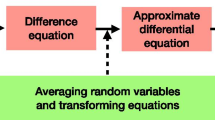Abstract
This work investigates how local preferences, social structural constraints and randomness might affect the development of the friendship network in Facebook. We do this by analyzing a snapshot Facebook dataset of Princeton University’s students, and by building an agent-based simulation for comparison. Several different, but plausible, processes of friendship network development are proposed in which the structural information of the growing network and the student preferences are taken into account and then compared with the data. ‘Network formation based on personal preference and social structure with some randomness’ matches the data best, and is thus the preferred hypothesis for the way that students add “friends” on Facebook.
Access this chapter
Tax calculation will be finalised at checkout
Purchases are for personal use only
Similar content being viewed by others
References
Abbas S (2011) An agent-based model of the development of friendship links within Facebook. In: 7th European social simulation association conference, Montpellier, France
Abbas S (2011) Ethnic diversity in Facebook. Methodology. Manchester. Retrieved from http://www.cfpm.org/~ali/FacebookReport/FacebookOnomapGroupReport.pdf
Adamic L, Buyukkokten O, Adar E (2003) A social network caught in the web. First Monday 8:1–22
Agarwal A, Chakrabarti S (2007) Learning random walks to rank nodes in graphs. In: Proceedings of the 24th international conference on Machine learning (ICML’07), pp 9–16. doi:10.1145/1273496.1273498
Airoldi EM, Blei DM, Fienberg SE, Xing EP (2008) Mixed membership stochastic blockmodels. J Mach Learn Res 9:1981–2014. Retrieved from: http://www.pubmedcentral.nih.gov/articlerender.fcgi?artid=3119541&tool=pmcentrez&rendertype=abstract
Backstrom L, Leskovec J (2011) Supervised random walks: predicting and recommending links in social networks. In: Proceedings of the fourth ACM international conference on Web search and data mining, pp 635–644. doi:10.1145/1935826.1935914
Barabási AL, Albert R (1999) Emergence of scaling in random networks. Science 286(5439):509–512. doi:10.1126/science.286.5439.509
Boyd DM, Ellison NB (2007) Social network sites: definition, history, and scholarship. J Comput-Mediat Commun 13(1):210–230. doi:10.1111/j.1083-6101.2007.00393.x
Ellison NB, Steinfield C, Lampe C (2007) The benefits of Facebook “Friends”: social capital and college students’ use of online social network sites. J Comput-Mediat Commun 12(4):1143–1168. doi:10.1111/j.1083-6101.2007.00367.x
Gao B, Liu T, Wei W, Wang T (2011) Semi-supervised ranking on very large graphs with rich metadata. In: Proceedings of the 17th ACM SIGKDD international conference on knowledge discovery and data mining, vol 49, pp 96–104. doi:10.1145/2020408.2020430
Gjoka M, Kurant M, Butts C (2009) Unbiased sampling of Facebook. Search, pp 1–15. Retrieved from http://scholar.google.com/scholar?hl=en&btnG=Search&q=intitle:Unbiased+Sampling+of+Facebook#0
Golder SA, Wilkinson D, Huberman BA (2007) Rhythms of social interaction: messaging within a massive online network. In: Steinfield C, Pentland B, Lewis AK et al. (eds) Social networks, vol 30, pp 330–342
Hamill L (2010) Communications, travel and social networks since 1840: a study using agent-based models. In: Social networks
Hamill L, Gilbert N (2008) A simple but more realistic agent-based model of a social network. In: Proceedings of European social simulation association annual conference, Brescia, Italy
Jackson MO, Rogers BW (2007) Meeting strangers and friends of friends: how random are social networks? Am Econ Rev 97(3):890–915. doi:10.1257/aer.97.3.890
Kim M (2010) Multiplicative attribute graph model of real-world networks. Internet Math 8(1–2):113–160. doi:10.1080/15427951.2012.625257
Krackhardt D, Stern RN (2011) Informal networks and organizational crises: an experimental simulation ∗. Soc Psychol Q 51(2):123–140
Kumar R, Novak J (2010) Structure and evolution of online social networks. In: Link mining: models, algorithms, and applications, pp 337–357. Retrieved from http://www.springerlink.com/index/X246586QW2477685.pdf
Kurant M, Gjoka M, Butts C (2011) Walking on a graph with a magnifying glass: stratified sampling via weighted random walks. ACM SIGMETRICS Perform Eval Rev 39:241–252. doi:10.1145/2007116.2007145
Lewis K, Kaufman J, Gonzalez M, Wimmer A, Christakis N (2008) Tastes, ties, and time: a new social network dataset using Facebook.com. Soc Netw 30(4):330–342. doi:10.1016/j.socnet.2008.07.002
Marmaros D, Sacerdote B (2006) How do friendships form? Q J Econ 121(1):79–119. doi:10.1162/003355306776083563
Mayer A (2009) Online social networks in economics. Decis Support Syst 47(3):169–184. doi:10.1016/j.dss.2009.02.009
Mayer A, Puller SL (2008) The old boy (and girl) network: social network formation on university campuses. J Public Econ 92:329–347
McPherson M, Smith-Lovin L, Cook JM (2001) Birds of a feather: homophily in social networks. Annu Rev Sociol 27(1):415–444. doi:10.1146/annurev.soc.27.1.415
Mislove A, Marcon M, Gummadi KP, Druschel P, Bhattacharjee S, Bhattacharjee B (2007) Measurement and analysis of online social networks. In: Proceedings of the 7th ACM SIGCOMM conference on internet measurement (IMC’07), p 29. doi:10.1145/1298306.1298311
Mislove A, Viswanath B, Gummadi KP, Druschel P (2010) You are who you know: inferring user profiles in online social networks. In: Proceedings of the third ACM international conference on web search and data mining, pp 251–260
Newman M (2003) Mixing patterns in networks. Phys Rev E 67:026126. Retrieved from http://pre.aps.org/abstract/PRE/v67/i2/e026126
Panzarasa P, Opsahl T, Carley KM (2009) Patterns and dynamics of users’ behavior and interaction: network analysis of an online community. J Am Soc Inf Sci 60(5):911–932. doi:10.1002/asi.21015
Pattison P (1996) Logit models and logistic regressions for social networks. Psychometrika 61(3):401–425. Retrieved from http://www.springerlink.com/index/T2W46715636R2H11.pdf
Singer HM, Singer I, Herrmann HJ (2009) Agent-based model for friendship in social networks. Phys Rev E, Stat Nonlinear Soft Matter Phys 80(2):026113. Retrieved from http://www.ncbi.nlm.nih.gov/pubmed/19792206
Traud A, Kelsic E, Mucha P (2008) Community structure in online collegiate social networks. Organization, pp 1–15. Retrieved from http://www.uvm.edu/~pdodds/files/papers/others/2008/traud2008a.pdf
Wilson C, Boe B, Sala A, Puttaswamy KPN, Zhao BY (2009) User interactions in social networks and their implications. In: Proceedings of the fourth ACM European conference on Computer systems (EuroSys’09), p 205. doi:10.1145/1519065.1519089
Acknowledgements
We would thank our colleagues at the Centre for Policy Modelling for their helpful comments and feedback. We also would like to thank Mason Porter of Oxford University, who shared the underlying dataset with us.
Author information
Authors and Affiliations
Corresponding author
Editor information
Editors and Affiliations
Rights and permissions
Copyright information
© 2013 Springer International Publishing Switzerland
About this paper
Cite this paper
Abbas, S. (2013). Popularity and Similarity Among Friends: An Agent-Based Model for Friendship Development. In: Gilbert, T., Kirkilionis, M., Nicolis, G. (eds) Proceedings of the European Conference on Complex Systems 2012. Springer Proceedings in Complexity. Springer, Cham. https://doi.org/10.1007/978-3-319-00395-5_77
Download citation
DOI: https://doi.org/10.1007/978-3-319-00395-5_77
Publisher Name: Springer, Cham
Print ISBN: 978-3-319-00394-8
Online ISBN: 978-3-319-00395-5
eBook Packages: Physics and AstronomyPhysics and Astronomy (R0)




